Veg Kurma, also known as Veg Korma, is a comforting medley of mixed vegetables slow-cooked in a rich, mildly spiced, and aromatic gravy. This dish is popular across various Indian cuisines, with each region lending its character and twist to the recipe.
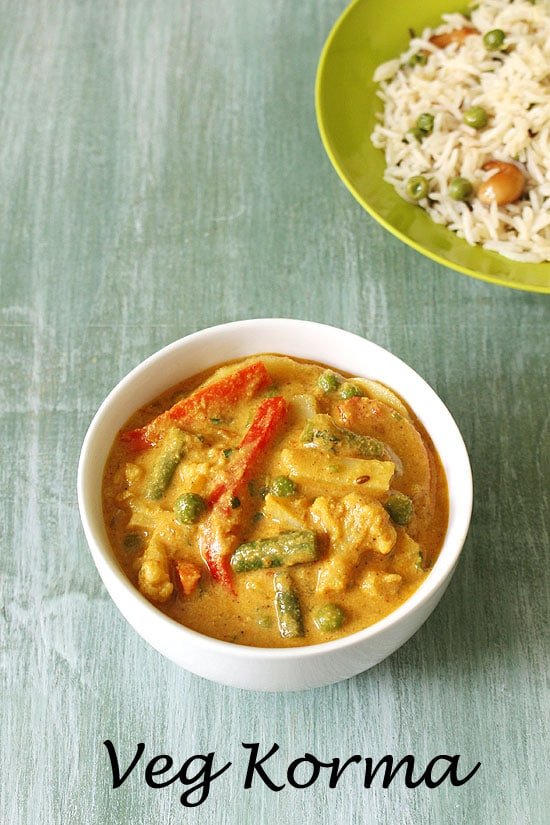
From the Mughlai korma that uses saffron, khoya, and ground nuts to achieve a regal richness, to the Shahi korma of North India that features cream for a luscious texture, and the Kashmiri version that includes yogurt, nuts, and dried fruits, each variation is distinct and delightful in its way.
This recipe features a classic South Indian hotel-style Veg Kurma, made with a delicious blend of coconut and yogurt that creates a subtly spiced, aromatic gravy. It’s light on the stomach yet full of rich, satisfying flavor. The subtle sweetness from coconut, the tang from yogurt, and the gentle warmth of spices make this kurma truly comforting and soul-satisfying.
If you enjoy a spicier kick, simply increase the quantity of green chilies or add extra red chili powder to adjust the heat to your liking. This kurma pairs beautifully with chapati, parotta, puri, or even rice, making it a versatile addition to your menu.
While there are other delectable korma variations like Navratna Korma (rich with fruits and nuts) and Paneer Korma (a creamy cottage cheese delight), I’ll be sharing those recipes soon. For now, let’s dive into this South Indian-inspired Veg Kurma that brings restaurant flavors straight to your home kitchen.
Ingredients For Veg Kurma:
For the Fresh Spice & Coconut Paste
- This flavorful blend forms the heart of South Indian-style kurma, lending it its distinct aroma and taste.
- 3 tablespoons grated coconut – You can use either freshly grated or frozen coconut; both work beautifully.
- 6 to 7 cashew nuts – Adds a subtle creaminess and richness to the gravy.
- 1 teaspoon white poppy seeds (khas khas) – Gives a slightly nutty flavor and helps thicken the paste.
- 2 green cardamoms – Infuses the curry with a sweet and floral aroma.
- 2 cloves – Offers warm and pungent undertones.
- ½ inch cinnamon stick – Brings warmth and a subtle woody note to the masala.
- 4 to 5 black peppercorns – Adds mild heat and earthiness.
- ½ teaspoon cumin seeds – For a slight bitterness and aroma that balances the richness.
- 1-inch chunk of fresh ginger, finely chopped – Adds a bright, pungent kick with a hint of warmth.
- 2 garlic cloves – Brings robust, savory notes that deepen the overall flavor of the dish.
- 1 green chili, chopped – Adjust quantity to make it more or less spicy.
- ⅓ cup water – To blend all the ingredients into a smooth, thick paste.
For the Vegetables:
- Use a colorful mix of vegetables for taste, texture, and nutrition:
- ⅓ cup potatoes, sliced into long, thin strips – They soak up the flavor beautifully.
- ⅓ cup green beans (French beans), cut into 1-inch pieces – Adds a nice crunch.
- 1 cup capsicum (bell pepper) – I’ve used red bell pepper, but green or yellow also work.
- ⅓ cup carrots, julienned or cut into matchstick-style – For sweetness and color.
- ⅓ cup green peas – Use fresh or frozen; they cook quickly and add sweetness.
- ⅓ cup cauliflower florets – Light and spongy, they absorb the gravy well.
- You can adjust the type or quantity of vegetables to suit your taste. The combined quantity of vegetables comes to approximately 2 cups in total.
For the Curry Base
- This creates the delicious base that supports all the vibrant flavors in your vegetable kurma.
- 2 tablespoons oil – Use any neutral cooking oil (like sunflower or vegetable oil).
- Sure! Here’s the rephrased version with a transition phrase:
- Then, add ½ cup of finely chopped red onion and sauté until it turns soft and lightly golden, releasing its natural sweetness into the curry.
- 1 medium tomato, pureed – Adds a slight tang and helps thicken the base.
- ¼ teaspoon turmeric powder – Adds a golden hue and a gentle, earthy note to the dish.
- 1 teaspoon red chili powder – Adjust according to your heat preference.
- 1 teaspoon coriander powder – Adds warmth and depth to the curry.
- Salt to taste – Balances and brings out the natural flavors of all the ingredients.
- Next, add 3 tablespoons of plain yogurt (curd or dahi) — but first, whisk it until smooth. This step adds creaminess and a subtle tang to the curry.
- 1½ cups water – Adjust based on your desired consistency of the kurma.
- 2 tablespoons finely chopped coriander (cilantro) leaves – For a fresh and vibrant finish.
Step-by-Step Instructions:
1) Pre-cook the vegetables: Start by partially cooking the mixed vegetables (except capsicum). I used a microwave for convenience, but you can also steam them, lightly sauté them in a pan, or use a pressure cooker—whichever method you prefer.
2) Microwave method (used here): Place the chopped vegetables (excluding capsicum) in a microwave-safe bowl. Add a pinch of salt and a few tablespoons of water to help them steam.
3) Cook until partially done: Cover the bowl and microwave on high power for around 5 minutes or until the vegetables are about 70% cooked. The vegetables should be partially cooked—soft enough to bite into, yet firm enough to retain their shape.
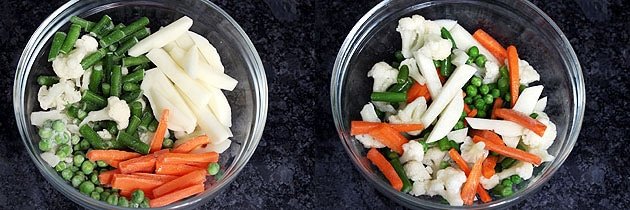
4) Add bell peppers: Now, stir in the capsicum (bell peppers). Cover again and cook until all the vegetables are fully cooked but not mushy—another 2 to 3 minutes depending on your microwave.
5) Alternative cooking methods:
To steam the vegetables, you can follow a method similar to the one used in the Veg Makhanwala recipe.
If you prefer to cook them in a pan, use the approach typically followed in making Veg Kadai.
For pressure cooking guidance, follow the approach from the Veg Cutlet recipe.
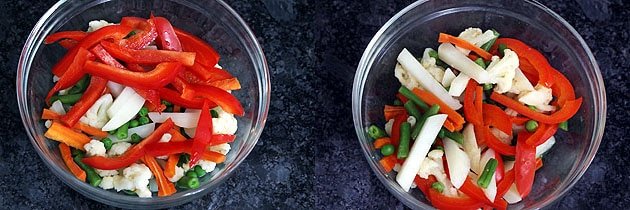
6) Prepare the spice paste: In a blender or chutney grinder jar, combine all the ingredients for the masala paste—grated coconut, cashew nuts, poppy seeds, green cardamoms, cloves, cinnamon, black peppercorns, cumin seeds, chopped ginger, garlic cloves, and green chili.
7) Add water and grind: Pour in about ⅓ cup of water and grind until you get a smooth, lump-free paste. Scrape down the sides if necessary. Set this aside for later use.

8) Start the base of the curry: Heat oil in a deep pan or kadhai over medium heat. Once the oil is hot, add the finely chopped red onions.
9) Sauté the onions: Cook them gently until they turn soft, look slightly transparent, and take on a pale pink color. Stir occasionally to prevent them from sticking or browning too much.
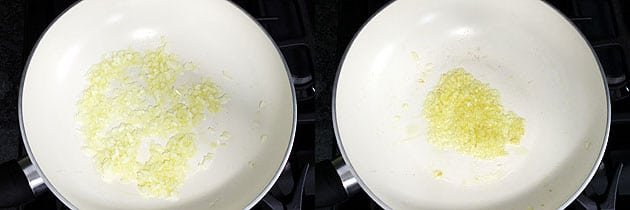
10) Add tomato puree: Pour in the pureed tomato and continue to cook the mixture.
11) Cook till thick: Let the tomato mixture cook down until all the moisture evaporates and it transforms into a thick, rich paste.
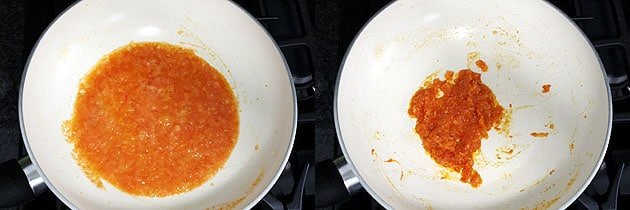
12) Incorporate the spices: Add turmeric, red chili powder, coriander powder, and salt to boost the aroma, spice level, and overall richness of the curry.
13) Combine and sauté: Stir the mixture thoroughly and cook it for a minute to mellow the raw taste of the spices and let their flavors develop.
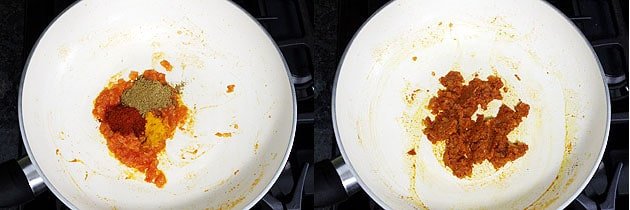
14) Add the ground paste: Now, introduce the prepared coconut-spice paste to the pan.
15) Sauté the paste: Mix it into the masala base and let it cook for a minute so the spices blend well and release their aroma.

16) Adjust consistency: Pour in 1½ cups of water (or as needed) to bring the mixture to a curry-like consistency. Stir well to avoid lumps.
17) Let it simmer: Allow the gravy to gently simmer on medium heat for 5–6 minutes so the masala cooks thoroughly and releases its aroma.

18) Add the yogurt: Reduce the flame to low and gently stir in the well-whisked yogurt, blending it smoothly into the simmering curry.
19) Mix quickly: Stir immediately and continuously after adding yogurt to prevent it from curdling. Let it return to a gentle simmer.
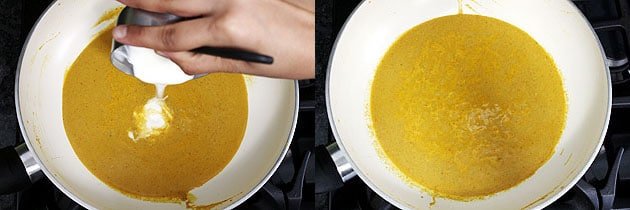
20) Add cooked vegetables: Now, add the pre-cooked vegetables into the curry. Stir thoroughly to ensure the vegetables are evenly covered in the rich, spiced gravy.
21) Simmer Again: After adding the vegetables, allow the kurma to simmer for an additional 4–5 minutes. This allows the vegetables to soak up all the rich flavors of the gravy. If, at this stage, the curry appears too thick, you can easily adjust the consistency by stirring in a little warm water until it reaches your preferred texture.
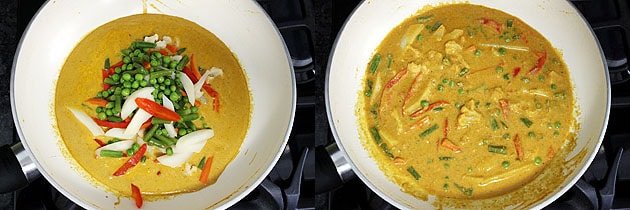
22) Final touch: Sprinkle freshly chopped coriander (cilantro) leaves on top for a burst of freshness and color.
23) Turn off the heat: Give the Veg Kurma one last stir and switch off the stove. Allow the Veg Kurma to sit for a few minutes so the flavors can settle and deepen before serving.

Expert Tips for Perfect Veg Kurma:
- Use Fresh Ingredients: To achieve the most authentic flavor and a rich texture, it’s best to opt for freshly grated coconut whenever possible. Not only does it add natural sweetness, but it also brings a nutty depth that frozen or dried versions often lack. That said, if frozen coconut is your only option, be sure to thaw it completely before blending. Doing so will ensure a smooth, lump-free paste that integrates seamlessly into the curry.
- Don’t Overcook the Vegetables: Vegetables should be tender yet firm, not mushy. Overcooking can break them down and ruin the texture of the kurma.
- Balance the Yogurt: Always use fresh, slightly thick yogurt. Make sure it’s at room temperature and whisked well before adding to the curry to prevent curdling. Stir immediately after adding and keep the flame low.
- Use Whole Spices for Paste: Avoid skipping any spices in the coconut paste. The whole spices like cardamom, cloves, and peppercorns give the Veg Kurma its signature restaurant-style aroma and depth.
- Customize Heat Levels: If serving to kids or those who prefer milder flavors, reduce the green chili and chili powder. To increase the heat, consider sprinkling a little garam masala near the end of cooking for an extra layer of bold flavor.

Serving Suggestions For Veg Kurma:
- With Indian Breads: Veg Kurma pairs wonderfully with soft chapatis, flaky parottas, pooris, or even butter naan.
- When served with rice, this kurma pairs beautifully with plain basmati rice, jeera rice, or mildly spiced ghee rice, making for a comforting and wholesome meal.
- For accompaniments, consider serving a side of raita or a simple cucumber salad, which offer a refreshing contrast to the rich flavors of the kurma.
